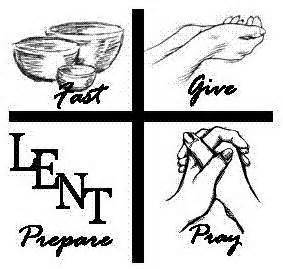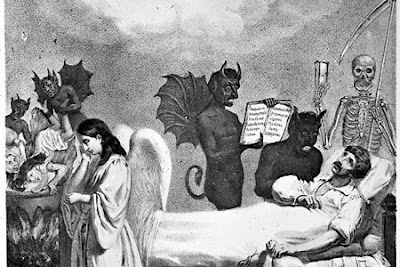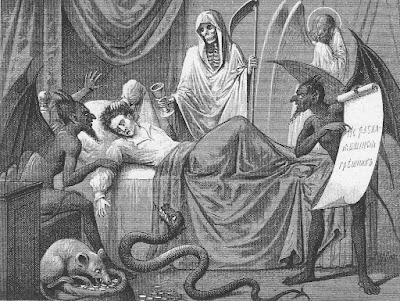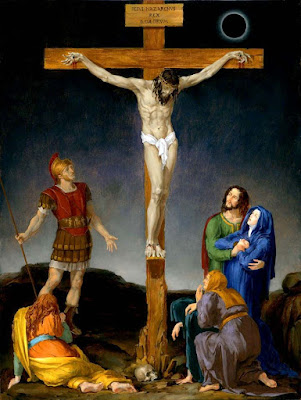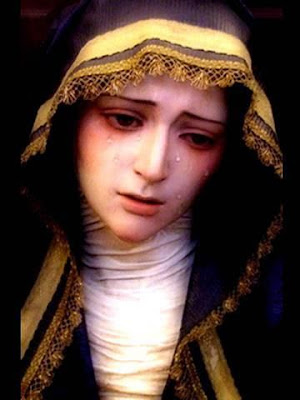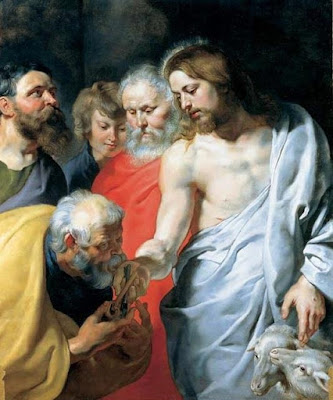 |
| Bronze statue of St. Peter sitting on the Chair of Peter |
From
the Earliest
Days of the Church
a Part of Church History
Chair of St. Peter, Apostle Feast Day
The annual feast of cathedra petri at Rome
From the earliest times the Church at Rome celebrated on 18
January . . .
the memory of the day when the Apostle
held his first service with the
faithful of the Eternal City.
According to Duchesne and de Rossi, the
"Martyrologium Hieronymianum" (Weissenburg manuscript) reads as
follows:
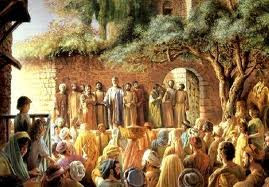 |
| St. Peter teaching |
"XV KL. FEBO. Dedicatio cathedræ sci petri apostoli
qua primo
Rome petrus apostolus sedit"
(fifteenth day before the calends of
February,
the dedication of the Chair of
St. Peter the Apostle
in which Peter
the Apostle first sat at Rome).
The Epternach manuscript (Codex Epternacensis)
of the same work, says briefly: "cath. petri in roma" (the Chair of
Peter in Rome).
In its present (ninth-century) form the "Martyrologium
Hieronymianum" gives a second feast of the Chair of St. Peter for 22
February, but all the manuscripts assign it to Antioch, not to Rome.
Thus the
oldest manuscript, that of Berne, says: "VIII kal. mar. cathedræ sci petri
apostoli qua sedit apud antiochiam". The Weissenburg manuscript says:
"Natl [natale] sci petri apostoli cathedræ qua sedit apud antiocia."
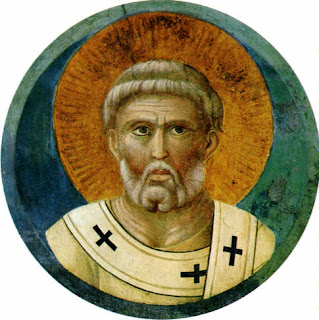 |
| St. Peter the Apostle |
However, the words qua sedit apud antiochiam are seen at once to be a later
addition.
Both feasts are Roman; indeed, that of 22 February was originally the
more important.
This is clear from the Calendar of Philocalus drawn up in the
year 354, and going back to the year 311; it makes no mention of the January
feast but speaks thus of 22 February:
"VIII Kl. Martias: natale Petri de
cathedra"
(eighth day before the Calends of March,
the birthday [i.e. feast]
of the Chair of Peter).
It was not until after the insertion of Antioch in the
copies of the "Martyrologium Hieronymianum" that the feast of
February gave way in importance to that of January.
The Roman Church,
therefore, at an early date celebrated a first and a second assumption of the
episcopal office in Rome by St. Peter. This double celebration was also held in
two places, in the Vatican Basilica and in a cemetery (coemeterium) on the Via
Salaria.
At both places a chair (cathedra) was venerated which the Apostle had
used as presiding officer of the assembly of the faithful.
The first of these
chairs stood in the Vatican Basilica, in the baptismal chapel built by Pope
Damasus; the neophytes in albis (white baptismal robes) were led from the
baptistery to the pope seated on this ancient cathedra, and received from him
the consignatio, i.e. the Sacrament of Confirmation.
Reference is made to this
custom in an inscription of Damasus which contains the line: "una Petri
sedes, unum verumque lavacrum" (one Chair of Peter, one true font of
baptism).
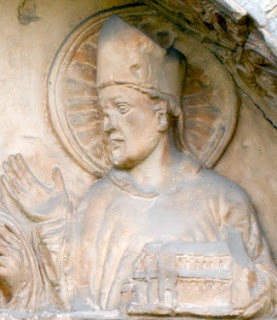 |
| St. Ennodius of Pavia |
St. Ennodius of Pavia (d. 521) speaks of it thus ("Libellus pro
Synodo", near the end): "Ecce nunc ad gestatoriam sellam apostolicæ
confessionis uda mittunt limina candidatos; et uberibus gaudio exactore fletibus
collata Dei beneficio dona geminantur"
(Behold now the neophytes go from
the dripping threshold to the portable chair of the Apostolic confession; amid
abundant tears called forth by joy the gifts of Divine grace are doubled).
While therefore in the apse of the Vatican Basilica there stood a cathedra on
which the pope sat amid the Roman clergy during the pontifical Mass, there was
also in the same building a second cathedra from which the pope administered to
the newly baptized the Sacrament of Confirmation.
The Chair of St. Peter in the
apse was made of marble and was built into the wall, that of the baptistery was
movable and could be carried.
Ennodius calls the latter a gestatoria sedes;
throughout the Middle Ages it was always brought on 22 February from the above-mentioned
consignatorium or place of confirmation to the high altar.
That day the pope
did not use the marble cathedra at the back of the apse but sat on this movable
cathedra, which was, consequently, made of wood.
 |
| Christ said, Because you have answered thus -Thou art Peter (Cephas) the ROCK on which I will build my Church |
The importance of this feast
was heightened
by the fact that 22 February was considered
the anniversary of
the day when Peter bore witness,
by the Sea of Tiberias, to the Divinity of
Christ
and was again appointed by Christ to be
the Rock of His Church.
According to very ancient Western liturgies,
22 February was the day
"quo
electus est 1. Petrus papa"
(on which Peter was first chosen pope).
The
Mass of this feast calls it at the beginning: "solemnitatis prædicandæ
dies præcipue nobilis in quo . . . . beatus Bar-Jona voce Redemptoris fide
devotâ prælatus est et per hanc Petri petram basis ecclesiæ fixus est",
i.e. this day is called especially praiseworthy because on it the blessed
Bar-Jona, by reason of his devout faith, was raised to pre-eminence by the
words of the Redeemer, and through this rock of Peter was established the
foundation of the Church.
And the Oratio (collect) says: "Deus, qui
hodiernâ die beatum Petrum post te dedisti caput ecclesiæ, cum te ille vere
confessus sit" (O God, who didst this day give us as head of the Church,
after Thyself, the Blessed Peter, etc.).
The second of the aforementioned chairs is referred to about
600 by an Abbot Johannes. He had been commissioned by Pope Gregory the Great to
collect in special little phials oil from the lamps which burned at the graves
of the Roman martyrs for the Lombard queen,
Theodolinda.
According to the manuscript list of these oils preserved in the
cathedral treasury of Monza, Italy, one of these vessels had on it the
statement: "oleo de sede ubi prius sedit sanctus Petrus" (oils from
the chair where St. Peter first sat).
Other ancient authorities describe the
site as "ubi Petrus baptizabat" (where Peter baptized), or "ad
fontes sancti Petri; ad Nymphas sancti Petri" (at the fountain of Saint
Peter).
Formerly this site was pointed out in the coemeterium majus (principal
cemetery) on the Via Nomentana; it is now certain that it was on the Via
Salaria, and was connected with the coemeterium, or cemetery, of Priscilla and
the villa of the Acilii (Acilii Glabriones), situated above this catacomb.
The
foundation of this villa, showing masonry of a very early date (opus
reticulatum), still exists. Both villa and cemetery, in one of whose burial
chambers are several epitaphs of members of the family, or gens, of the Acilii,
belong to the Apostolic Period.
It is most probable that Priscilla, who gave
her name as foundress to the catacomb, was the wife of Acilius Glabrio,
executed under Domitian. There is hardly any doubt that the site, "ubi
prius sedit sanctus Petrus, ubi Petrus baptizabat" (where Saint Peter
first sat, where Peter baptized), should be sought, not in an underground
cubiculum (chamber) in the catacombs, but in an oratory above ground. At least
nothing has been found in the oldest part of the cemetery of Priscilla now
fully excavated, referring to a cathedra, or chair.
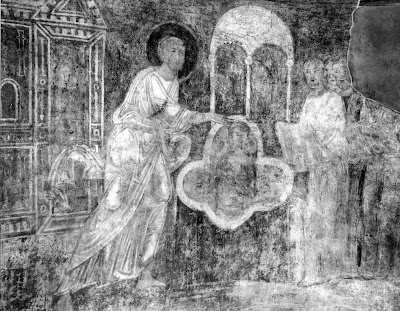 |
St. Peter Baptizing the Daughter of Centurion Cornelius
|
The feast of the Cathedra Petri was therefore celebrated on
the Via Salaria on 18 January; in the Vatican Basilica it was observed on 22
February.
It is easy to believe that after the triumph of Christianity the
festival could be celebrated with greater pomp in the magnificent basilica
erected by Constantine the Great over the confessio, or grave of Peter, than in
a chapel far distant from the city on the Via Salaria.
Yet the latter could
rightly boast in its favor that it was there Saint Peter first exercised at
Rome the episcopal office ("ubi prius sedit sanctus Petrus", as Abbot
Johannes wrote, or "qua primo Rome petrus apostolus sedit", as we
read in the "Martyrologium Hieronymianum" at 18 January).
This double
festival of the Chair of St. Peter is generally attributed to a long absence of
the Apostle from Rome. As, how ever, the spot, "ubi s. Petrus baptizabat,
ubi prius sedit" was distant from the city, it is natural to think that
the second feast of the cathedra is connected with the opening of a chapel for
Christian worship in the city itself.
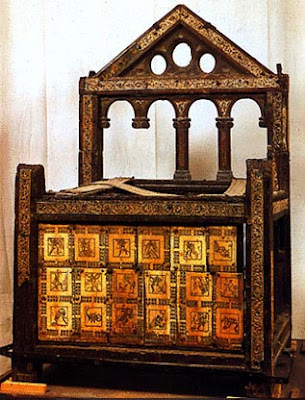 |
| Chair of Peter (Vatican Basilica) |
The Chair Itself
The Goths, who conquered and pillaged Rome in 410, advanced
toward the city by the Via Salaria and the Via Nomentana; the same roads were
traversed in the sixth and seventh centuries by later German invaders of Roman
territory.
Not only the churches, therefore, but even the cemeteries on these
thoroughfares were easily given to plunder and devastation.
We have seen,
moreover, that as late as 600 a lamp was burning on the site "ubi prius
sedit sanctus Petrus".
If the original chair of the Apostle had still been
there at that time, would it have been saved from destruction in the pillage
that did not spare the sarcophagi in the catacombs?
The words of the Abbot
Johannes, "oleo de sede, ubi prius sedit sanctus Petrus", seem to
leave scarcely a doubt as to this. The fact, evidenced by the martyrologies
(see above), that by the ninth century one of the two feasts of the Roman
cathedra had drifted away to Antioch, shows that the cathedra of the Via
Salaria must have perished as early as the sixth or seventh century.
We come now to the question, where stood originally the
chair shown and venerated in the Vatican Basilica during the fourth century?
On
the strength of ancient tradition it has been customary to designate the church
of Santa Pudenziana as the spot where, in the house of the supposed Senator
Pudens, the two great Apostles not only received hospitable entertainment, but
also held Christian services.
But the legends connected with Santa Pudenziana
do not offer sufficient guarantee for the theory that this church was the
cathedral and residence of the popes before Constantine.
At the close of his
Epistle to the Romans (xvi, 5), St. Paul mentions a place where religious
services were held, the house of Aquila and Prisca (ten kat oikon auton
ekklesian — now Santa Prisca on the Aventine).
Aquila and Prisca are first
among the many to whom the Apostle sends salutations. Aquila's connexion with
the Catacomb of Priscilla is still shown by the epitaphs of that burial place.
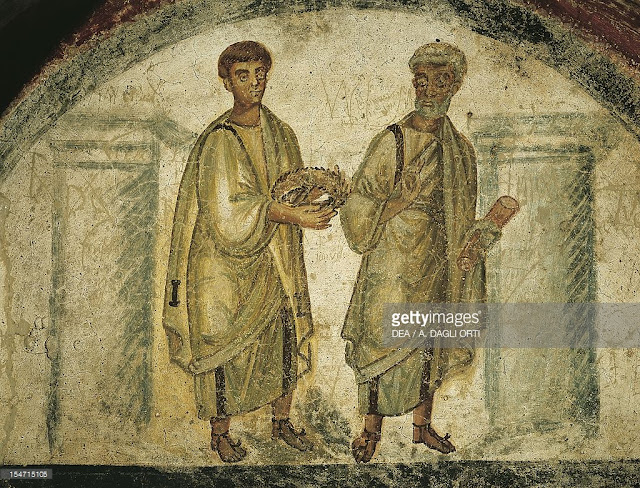 |
| Sts Peter and Paul carrying Crown of Martyrdom, fresco of the arcosolium, Catacombs |
In 1776 there was excavated on the Aventine, near the present church of Santa
Prisca, a chapel with frescoes of the fourth century; in these frescoes
pictures of the two Apostles were still recognizable.
Among the rubbish was
also found a gilded glass with the figures of Peter and Paul.
The feast of the
dedication of this church (an important point) still falls on the same day as
the above-described cathedra feast of 22 February; this church, therefore, continued
to celebrate the traditional feast even after the destruction of the object
from which it sprang.
 |
| In the crypt of Santa Prisca |
In the crypt of Santa Prisca is shown a hollowed capital,
bearing in thirteenth-century letters the inscription: BAPTISMUS SANCTI PETRI
(Baptism of Saint Peter), undoubtedly the echo of an ancient tradition of the
administration of baptism here by Peter.
In this way we have linked together a
series of considerations which make it probable that the spot "ubi secundo
sedebat sanctus Petrus" (where Saint Peter sat for the second time), must
be sought in the present church of Santa Prisca; in other words, that the chair
referred to by St. Damasus was kept there in the period before Constantine. It
was there, consequently, that was celebrated the "natale Petri de
cathedrâ", set for 22 February in the calendars beginning with the year
354.
It follows also that this is the cathedra referred to in the oldest
testimonia which speak of the chair from which Peter taught at Rome. The
(third-century) poem, "Adversus Marcionem", says (P.L., II, 1099):
Hâc cathedrâ, Petrus quâ sederat ipse, locatum
Maxima Roma Linum primum considere iussit.
(On this chair, where Peter himself had sat,
great Rome first placed Linus and bade him sit.)
 |
| St. Cyprian |
Further, St. Cyprian, writing about 250, during the vacancy
of the chair after the death of Pope St. Fabian, describes it as follows:
"Cum locus Fabiani, id est locus Petri et gradus cathedræ sacerdotalis
vacaret" (when the place of Fabian, i.e. the place of Peter and the step of
the sacerdotal chair were vacant).
Still earlier, about 200, Tertullian writes,
in his "De præscriptione bæreticorum": "Percurre ecclesias
apostolicas, apud quas ipsæ adhuc cathedræ apostolorum suis locis præsident. Si
Italiæ adjaces habes Romam" (Visit the Apostolic churches in (among) which
the very chairs of the Apostles still preside in their places. If you are near
Italy, there is Rome).
How Pope Damasus might be led to transfer the cathedra Petri
from Santa Prisca to the Vatican, can be readily understood from the
circumstances of that time.
From the reign of the first Constantine the Lateran
had been the residence of the popes, and its magnificent basilica their
cathedral, while the neighbouring baptistery of Constantine served for the
solemn administration of baptism on the eve of Easter.
In the half-century from
312 to 366 (date of the accession of Damasus), the importance of Santa Prisca,
its baptistery, and its cathedra must naturally have declined. Damasus could
therefore be certain of the approval of all Rome when he transferred the
venerable Apostolic relic from the small chapel in Santa Prisca to his own new
baptistery in the Vatican, where it certainly remained to the first quarter of
the sixth century, after which it was kept in different chapels of the Vatican
Basilica.
During the Middle Ages it was customary to exhibit it yearly to the
faithful; the newly-elected pope was also solemnly enthroned on this venerable
chair, a custom that ceased at the transfer of the papal capital to Avignon, in
the early part of the fourteenth century.
In order to preserve for posterity
this precious relic, Alexander VII (1655-67) enclosed, after the designs of
Bernini, the Cathedra Petri above the apsidal altar of St. Peter's in a
gigantic casing of bronze, supported by four Doctors of the Church (Ambrose,
Augustine, Athanasius, Chrysostom). Thenceforth, for 200 years, it was not
exhibited to the public.
In 1867, however, on the occasion of the eighteenth
centenary of the martyrdom of the two great Apostles, it was exposed for the
veneration of the faithful.
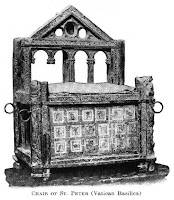 |
| Chair of St. Peter |
At that time the Alessandri brothers photographed
the chair, and that photograph is reproduced here.
The seat is about one foot
ten inches above the ground, and two feet eleven and seven-eighths inches wide;
the sides are two feet one and one-half inches deep; the height of the back up
to the tympanum is three feet five and one-third inches; the entire height of
the chair is four feet seven and one-eighth inches.
According to the
examination then made by Padre Garucci and Giovanni Battista de Rossi, the
oldest portion (see illustration) is a perfectly plain oaken arm-chair with
four legs connected by cross-bars. The wood is much worm-eaten, and pieces have
been cut from various spots at different times, evidently for relics. To the
right and left of the seat four strong iron rings, intended for carrying-poles,
are set into the legs.
At a later date, perhaps in the ninth century, this
famous chair was strengthened by the addition of pieces of acacia wood. The
latter wood has inlaid in it a rich ornamentation of ivory. For the adornment
of the front of the seat eighteen small panels of ivory have been used, on
which the labours of Hercules, also fabulous animals, have been engraved; in
like manner it was common at this period to ornament the covers of books and
reliquaries with ivory panels or carved stones representing mythological
scenes. The back is divided by small columns and arches into four fields and
finishes at the top in a tympanum which has for ornamentation a large round
opening between two smaller ones. The tympanum is surrounded on all sides by
strips of ivory engraved in arabesques. At the centre of the horizontal strip a
picture of an emperor (not seen in the illustration) is carved in the ivory; it
is held to be a portrait of Charles the Bald. The arabesque of acanthus leaves
filled with fantastic representations of animals, and the rough execution of
the work, would make the period of this emperor (884) a probable date.
What
still remains of the old cathedra scarcely permits an opinion as to the
original form. In any case it was a heavy chair made of plain, straight pieces
of wood, so that it cannot be considered a sella curulis of Pudens, as earlier
tradition held it to be. If the four rings on the two sides belong to the
original chair (Ennodius of Pavia about the sixth century used the term sedes
gestatoria as an expression universally understood in reference to this chair),
then it was probably an ordinary carrying-chair, such as was commonly used in
ancient Rome.
While the two chairs were the visible memorials of the
earliest origins of Peter's Apostolic work at Rome, the recollection of his
first arrival in the city is still preserved in the litanioe majores (greater
litanies) on 25 April.
On this day is also celebrated the feast of St. Mark,
whom St. Peter had sent to Alexandria in Egypt. Antioch and Alexandria, the two
most important patriarchates of the East, were, in common with Rome, founded by
Peter.
 |
| Pope St. Gregory the Great |
Gregory the Great refers as follows to this spiritual relationship with
the Roman Patriarchate of the West, in a letter to the Patriarch Eulogius
(P.L., LXXVII, 899): "Quum multi sint Apostoli, pro ipso autem principatu
sola Apostolorum principis sedes in auctoritate convaluit, quæ in tribus locis
unius est. Ipse enim sublimavit sedem, in quâ etiam quiescere et præsertim
vitam finire dignatus est. Ipse decoravit sedem, in quâ Evangelistam (Marcum)
discipulum misit. Ipse firmavit sedem, in quâ septem annis, quamvis
discessurus, sedit. Quum ergo unius atque una sit sedes, cui ex auctoritate
divinâ tres nunc episcopi præsident, quidquid ego de vobis boni audio, hoc mihi
imputo"
(Though there are many Apostles, pre-eminence of authority belongs
permanently to none other than the Chair of the Prince of the Apostles, which
Chair though established in three places remains nevertheless that of one and
the same [Apostle].
He lifted it to the highest dignity in the place [Rome]
where he deigned to fix his residence and end his life. He honoured it in the
city [Alexandria] to which he sent his disciple, the Evangelist Mark.
He
strengthened it in the city [Antioch] where, though destined to depart, he sat
for seven years. Since therefore the Chair in which now by divine authority
three bishops preside is the identical chair of the self-same [Peter], I take
myself whatever good I hear concerning you).
We conclude, therefore, that there is no reason for doubting
the genuineness of the relic preserved at the Vatican, and known as the
Cathedra Petri.
 |
Eusebius of Caesarea
|
According to Eusebius, Jerusalem preserved the cathedra of St.
James (Church History VII.19), Alexandria that of St. Mark (G. Secchi, La
cattedra alessandrina di San Marco, Venice, 1853).
Tertullian, in the above
quoted passage, refers to the value placed by the Apostolic Churches on the
possession of the chairs of their founders (apud quas ipsæ adhuc cathedræ
apostolorum suis locis præsident), and in enumerating them he puts Rome first.
Moreover, the other writers above quoted, and whose testimony reaches back to
the second century, all postulate the presence in Rome of an actual Cathedra
Petri,

